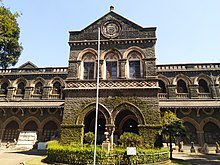Sir J. J. School of Art
 | |
| Type | Public art school |
|---|---|
| Established | March 1857 |
| Accreditation | AICTE |
| Affiliation | University of Mumbai |
| Dean | Vishwanath D. Sabale |
| Address | 18°56′42″N 72°50′01″E / 18.94505°N 72.83352°E |
| Campus | Urban |
| Website | www |
The Sir Jamsetjee Jeejeebhoy School of Art (Sir J. J. School of Art) is the oldest art institution in
History
Early history
The School founded in March 1857, was named after
In 1866, management of the school was taken over by the Government of India. Also in 1866,
Drawing instruction as a subject was introduced in 1879 and a programme for training drawing teachers was started in 1893. In 1891, the Lord Reay Art Workshops (now known as the Department of Art-Crafts) were established.
1900s
The School had an important tradition in architecture. In 1900, the School offered its first course in architecture, taught by John Begg, later Consulting Architect of Bombay and of the Government of India. A complete 4-year programme was established in 1908 under Begg's assistant George Wittet. In 1917, architect Claude Batley became a visiting professor; he was Principal of the School from 1923 to 1943, and is commemorated in the Claude Batley Architectural Gallery for architectural exhibitions, opened in 1996.
In 1896, the Draughtsman's classes, the nucleus of the Department of Architecture, were added. This Department was later organised for a 3 years Diploma Course which was duly recognised by the R.I.B.A. Board.
In 1910, the Sir George Clarke Studies and Laboratories were built for the advanced study of crafts, pottery being the first craft taken up for study. In 1929, the head of the School was renamed "Director", and in 1935, the Department of Commercial Art was also started.
In 1937
Post-independence
In 1958, the school was divided, with the Departments of Architecture and Applied Art becoming the Sir J. J. College of Architecture and Sir J.J. Institute of Applied Art respectively.
In 1981, the School became affiliated with the University of Mumbai.
List of alumni
- António Xavier Trindade
- Angela Trindade
- A. R. Hye(1919–2008)
- A.A. Raiba(1922–2016)
- Akbar Padamsee (1928–2020), painter
- Divita Rai Miss Universe India 2022
- Abid Surti (born 1935)
- Amol Palekar (born 1944), actor
- Antonio Piedade da Cruz (1895–1982), painter and sculptor[6]
- Arun Kolatkar (1932–2004)
- Atul Dodiya (born 1959)
- B. V. Doshi (1927-2023), architect
- Bhanu Athaiya (born 1929), costume designer
- Brendan Pereira (born 1928), advertiser
- Dadasaheb Phalke (1870–1944), film director
- Francis Newton Souza(1924–2002), painter
- Ganpatrao K Mhatre (1879–1947), sculptor[7]
- Govind Solegaonkar (1912–1986), painter
- Homai Vyarawalla (1913–2012), photojournalist,[8]
- James Ferreira (born 1956), fashion designer [9]
- Jatin Das (born 1941), painter
- Jitish Kallat (born 1974)
- Justin Samarasekera (1916–2003), architect
- K. K. Hebbar (1911–1996)
- Kalidas Shrestha (1923–2016)
- Laxman Pai (1926–2021), painter[10]
- M.F. Hussain (1915–2011), painter[11]
- M.V. Dhurandhar, (1867 – 1944) painter, vice-principal of the school
- Nadhiya (born 1966), actor [12]
- Nana Patekar (born 1951), actor and filmmaker [13]
- Nitin Chandrakant Desai, art director and production designer
- Pralhad Anant Dhond (1908–2001), Dean of Sir J. J. School of Art from 1958
- Pramila Dandavate (1928–2001), socialist leader and Member of Parliament, Lok Sabha[14]
- Prof. Sambhaji Kadam(1932–1998)
- R. D. Raval (1928–1980)
- R.Verman(1947–2019)
- Raj Thackeray (born 1968), president of Maharashtra Navnirman Sena
- Ram V. Sutar (born 1925), sculptor
- Ratnadeep Adivrekar (born 1974), artist
- Reena Saini Kallat (born 1973), painter
- Riyas Komu (born 1971), artist
- Syed Haider Raza (1922–2016), painter
- Sadanand Bakre (1920–1987), painter
- Saryu Doshi (born 1932), art historian and Padma Shri awardee[15]
- Shashi Bikram Shah (born 1940), Nepali artist
- Shivkar Bapuji Talpade (1864–1916)
- Tyeb Mehta (1925–2009), painter
- Uday Shankar (1900–1977), dancer[16]
- V. S. Gaitonde (1924–2001), painter [5]
- Waman Thakre (born 1932), photographer and Padma Shri awardee[17]
References
- Times of India, 6 October 2002.
- Indian Express, 2 March 2007. "...when the Public Works Department took up repainting of the building, the paintings had been shifted to the terrace and may have been washed out after the 26/7 deluge two years ago.(2005)"
- Times of India, Oct 5, 2007.
- ^ Times of India, Nov 7, 2008. "Kipling House (Dean's Bungalow)The original cottage was brought down in the early 1900s and a new house built on the same spot."
- ^ Times of India, 3 March 2007.
- ISBN 9788170226192
- ISBN 978-3-11-034136-2.
- ^ "Homai gets Padma Vibhushan". The Times of India. 25 January 2011. Archived from the original on 11 August 2011.
- ISBN 978-8171671557.
- ^ "Biography Laxman Pai". Ask Art. 2015. Retrieved 20 July 2015.
- ^ Kumar, Anu (9 January 1999). "JJ Institute: 150 years of lettering the poor". Indian Express. Archived from the original on 26 May 2009.
- ^ Kannan, Ganesh (18 March 2019). "Nadhiya". OneNov. Retrieved 13 April 2022.
- ^ "Archived copy". www.kokanworld.com. Archived from the original on 13 July 2011. Retrieved 13 January 2022.
{{cite web}}: CS1 maint: archived copy as title (link) - ^ Surana, Pannalal (2010). Buland Avaaj Baicha (बुलंद आवाज बाईचा). Sadhana Prakashan, Pune.
- ^ "Saryu Doshi - high priestess of the art world". DNA Syndicate. 1 October 2005. Retrieved 28 October 2015.
- ^ Islam, Sirajul (2012). "Uday Shankar". In Islam, Sirajul; Jamal, Ahmed A. (eds.). Banglapedia: National Encyclopedia of Bangladesh (Second ed.). Asiatic Society of Bangladesh.
- ^ "A photographer with a difference". Times of India. 23 April 2007. Retrieved 17 January 2016.
External links
- Official website
- Nandagaonkar, Satish (9 February 1005). "Sir J.J. School of Art, Mumbai". The Telegraph (Calcutta). Archived from the original on 13 September 2006.
